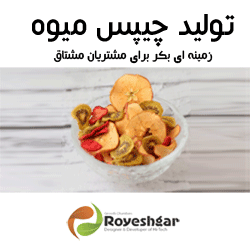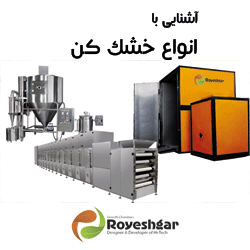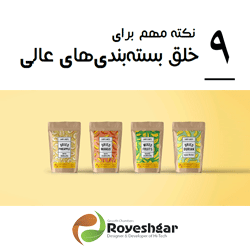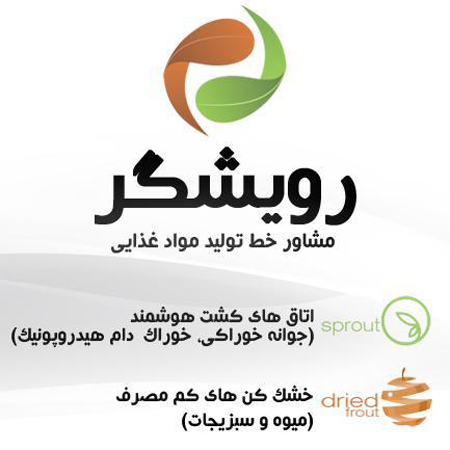
Royeshgar,the dominant company of July
August 5, 2019
Entrepreneurship with fruit dryer at home
October 16, 2019
Royeshgar,the dominant company of July
August 5, 2019
Entrepreneurship with fruit dryer at home
October 16, 2019Blanching (enzymatic degradation)
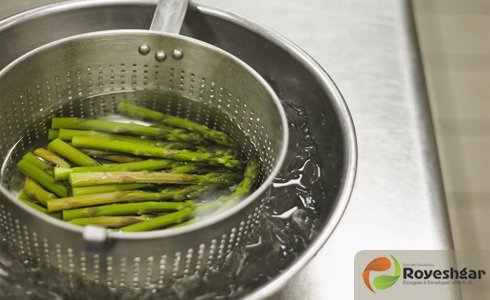
Introduction
Blanching is a process in which you boil or steam vegetables briefly until they are partially cooked then transferring it to an ice bath, which quickly stops the cooking.
The process has three stages:
- Preheating
- Blanching
- Cooling
Blanching is a cooking process wherein a food, usually a vegetable or fruit, is scalded in boiling water, removed after a brief, timed interval, and finally plunged into iced water or placed under cold running water (shocking or refreshing) to halt the cooking process.
its main purpose is to inactivate enzymes that cause browning as well as textural changes and off-flavors
Blanching foods helps reduce quality loss over time. People often use blanching as a pre-treatment prior to freezing, drying, or canning—heating vegetables or fruits to inactivate enzymes, modify texture, remove the peel, and wilt tissue. Blanching is also utilized to preserve color, flavor, and nutritional value. The most common blanching methods for vegetables/fruits are hot water and steam, while cooling is either done using cold water or cool air.
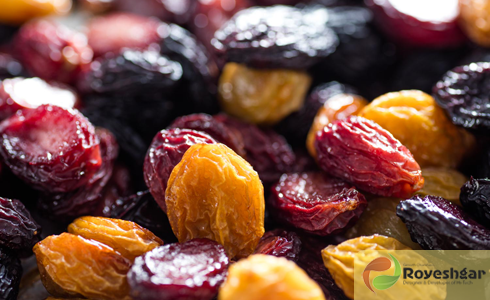
Fruits, vegetable, and nut peeling is also important in food processing. When almonds or pistachios are blanched, the skin of the nut (botanically the seed coat surrounding the embryo) softens and can be easily removed later. Steam peeling produces less environmental pollution and peeling losses, as compared to chemical or manual peeling processes.
Enzymes that cause deterioration in fruits and vegetables include lipoxygenase, polyphenoloxidase, polygalacturonase, and chlorophyllase.
Blanching preserves the flavors found in fruits and vegetables by inactivating enzymes responsible for off-flavor development.The most common enzyme responsible for off-flavors is lipoxygenase (LOX) and is found in several vegetables.
Other uses of blanching are enhancing drying rate and product quality, decreasing microbial load, removing pesticide and toxic residues, increasing extraction of bioactive compounds, surface cleaning, removing damaged seeds or foreign materials, killing parasites and their eggs, and reducing oil uptake.
Although blanching is a thermal process, the times and temperatures are not sufficient to effectively destroy all microorganisms.Blanching is often seen as a pre-process to later preservation steps. For example, blanching in the home is often done in combination with freezing; blanching in industry is also utilized before canning, dehydration, or heat sterilization.
The blanching process expels air trapped inside plant tissues, which is a vital step before canning and helps drying vegetables and fruits by using domestic and industrial dryers . Blanching prevents the expansion of air during processing, which reduces strain on the containers and the risk of cans having faulty seams. Moreover, removing gas from foods like pears results in better texture and reduces oxidation of the product. Also, the inter-cellular gases removed results in better color retention.
Blanching cleanses the surface of dirt and organisms, brightens the color and helps retard loss of vitamins. Other uses of blanching are enhancing drying rate and product quality, decreasing microbial load, removing pesticide and toxic residues, increasing extraction of bio-active compounds, surface cleaning, removing damaged seeds or foreign materials, killing parasites and their eggs, and reducing oil uptake.
Traditional and industrial blanching
Traditional enzymatic degradation was accomplished by a pool of water or saturated steam. In both methods, they heat the food for a short time and then immerse it in cold water or cool air to hasten the cooking and heating process. In the industrial sector, they place food on a conveyor belt and apply the heating, maintenance and cooling procedures.
Traditional blanching
For detoxification enzymes by hot water, vegetables are immersed in plenty of water pre-heated at 70 to 100 degrees that the time will depend on the type and quality of vegetables. The product is heated with water to a uniform temperature, especially with hot air.
This advantage also enables enzymatic deactivation by hot water at lower temperatures, but requires longer enzymatic degradation time. The water is heated and cooled using a temperature sensor and stored for later use, which reduces costs.
How can vegetables be enzymatic degraded in the traditional way?
The process of enzymatic degradation of vegetables is part of the process of preserving them when they are dried or frozen. Fresh vegetables should be slightly warmed and then cooled before drying in cool water. This process degrades the enzyme thus helping to maintain the quality of the vegetables. blanching is part of the process of and storing and preserving vegetables.
Boiling (using steam basket):
- Wash and prepare the vegetables.
- Pour some water into the pot.
- Put a steam basket into the pot.
- Wait for the water to boil.
- Pour the vegetables into the basket and make sure they are in a layer.
- Put the container cover.
- Boil again for one minute.
- enzymatic degradation
- Immediately place vegetables in a clean sink with plenty of ice and cold water and pour cold water over them.
- Dehydrate vegetable .
- The product is ready for drying and must be transferred to the dryer trays.
Boiling method (without steam basket):
- Use plenty of water. Add 2.8 liters of water per 450 kg of vegetables. This requires sufficient water to cook vegetables quickly. If the water content is low, the vegetables lose their color, texture and nutrients and become loose.
- Heat the vegetables Without putting the lid on the container. It is better to Cover the dish thus water boils sooner , but do not cover the dish when adding vegetables. Otherwise , the acid released from the vegetables will remain in the container and become loose and discolored.
- Raise the temperature. Boiling water is essential to keep the vegetables in good condition. Vegetables should be cooked as quickly as possible and boiling water makes this possible.
- Dry immediately. Don’t let the vegetables overheat, otherwise they will lose their freshness.
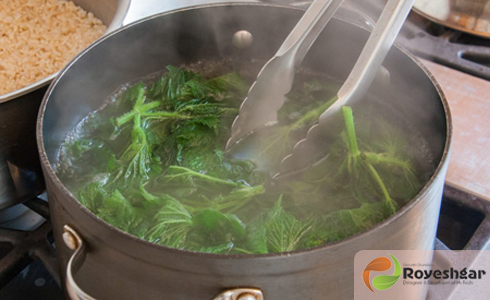
steam blanching:
- Prepare boiling water.
- Pour the vegetables into the steam basket.
- Hold the basket over the steam until they are cooked with steam. Steaming vegetables takes about 1 to 1.2 times more time than boiling.
- To find out whether or not the vegetable is enzymatic degraded , take a piece of it and taste it, if you like the texture, then it’s ready.
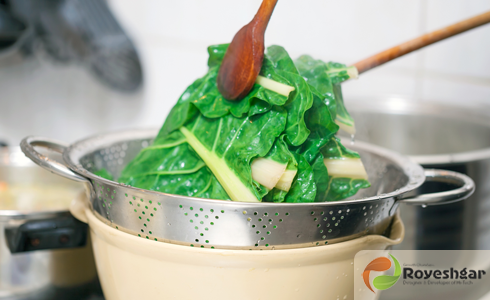
Industrial blanching
enzymatic degradation systems by steam expose food on a conveyor belt to hot air at temperatures close to 100 degrees. This method preserves water-soluble compounds and is suitable for small amounts of nutrients and those foods that are cut. Enzymatic degradation by saves energy consumption and its high heating ability shortens the process time. This results in the preservation of the color, taste and overall quality of the food; however, evaporation reduces the usefulness of the product.
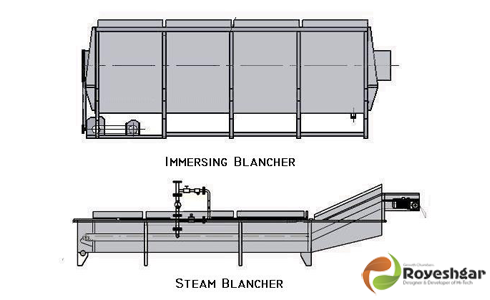
Vegetables and fruits are cooled immediately after being warmed by cold water. Another way to cool the product is to cool it with cold air. This cooling method avoids the dissolution of water-soluble nutrients; however, the air evaporates and reduces the volume of vegetables.
Newfound technologies include enzymatic degradation by using infrared , microwaves, and radio waves. Research has shown that this method cannot work because some enzymes do not deactivate. Therefore, it is better to use it for low volumes.
Time and temperature
In the process of food enzymatic degradation, it is important to consider the required time and temperature . Time and temperature are determined by the type of food, size, shape, and more. Excessive enzymatic degradation can lead to the loss of nutrients and compounds related to the taste and smell of food, as well as their deterioration. enzymatic degradation with temperature and time less than the required amount does not effectively degrade enzymes. This also causes more enzymes to exit the plant tissue, which in turn causes overall enzymatic activity and rapid decay of the product.
Disadvantages
Although enzymatic degradation is a heating process, time and temperature are not enough to kill all microorganisms. enzymatic degradation is often one step before product storage.
For example, enzymatic degradation at home are often associated with freezing; enzymatic degradation also occurs in the industry before compote, drying or heat sterilization.
Enzymatic degradation by hot water limitation is the elimination of water-soluble nutrients during smoothing as well as the reduction of heat-sensitive compounds. Vitamins, minerals, and other water-soluble compounds such as proteins, sugars, and flavoring compounds are excreted from the food and enter the water resulting reduction the quality of the food. The amount of nutrients excreted from food depends on its constituents, properties, water ratio, enzymatic degradation temperature, and other variables. Ascorbic acid, thiamine and many other components are heat-sensitive.
One of the issues to be addressed in the food industry is the production of Wastewater from enzymatic degradation by water. The enzymatic degradation used to produce water-soluble compounds which lead to contamination and therefore need to be thoughtful, as this has led to increased costs in the industry, caused, the development in new enzymatic degradation technologies

